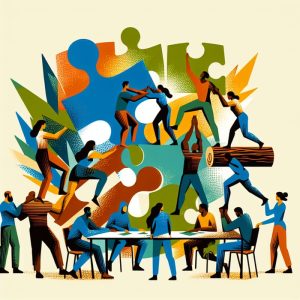Explanation of the Phrase “United We Stand, Divided We Fall”
The phrase “United We Stand, Divided We Fall” emphasizes the strength and success that comes from unity and the potential for failure when divided. Its origins can be traced to historical contexts, where collaboration and solidarity were necessary for survival and progress. The idea reflects that a group of individuals, working together toward a common goal, is far more powerful than those who are isolated or in conflict.
Importance of Togetherness in Personal, Social, and Global Contexts
 Togetherness is essential on multiple levels—personally, it fosters emotional support, builds trust, and creates meaningful relationships. Socially, it strengthens communities, promotes cooperation, and enhances collective well-being. On a global scale, togetherness is crucial in tackling shared challenges such as climate change, inequality, and pandemics, where international collaboration can lead to positive, lasting change.
Togetherness is essential on multiple levels—personally, it fosters emotional support, builds trust, and creates meaningful relationships. Socially, it strengthens communities, promotes cooperation, and enhances collective well-being. On a global scale, togetherness is crucial in tackling shared challenges such as climate change, inequality, and pandemics, where international collaboration can lead to positive, lasting change.
Brief Overview of the Article’s Focus on the Significance of Unity
This article will explore the concept of unity, highlighting its historical, social, and psychological importance. It will also discuss how unity strengthens societies and enables success, while disunity breeds division, conflict, and potential downfall. The article will provide real-world examples, demonstrate the dangers of division, and offer strategies for fostering a sense of togetherness in various settings.
Historical Perspective on Unity

The Role of Unity in Historical Movements
Throughout history, unity has been a driving force behind transformative movements. For instance, the Civil Rights Movement in the United States, led by figures like Martin Luther King Jr., succeeded in advancing racial equality because of the collective effort of diverse individuals committed to a common cause. Similarly, during World War II, the Allied Powers demonstrated the power of international cooperation, uniting against a common enemy to protect freedom and democracy. These examples illustrate how solidarity can mobilize people to achieve significant social and political changes.
Case Studies of Nations or Societies That Thrived Due to Solidarity
 History provides numerous examples of societies that flourished due to unity. Ancient Rome, at its height, grew into a vast empire by uniting under a strong leadership and a shared vision of expansion. Similarly, the formation of the European Union after World War II exemplified how nations that once were adversaries could unite for collective economic and political stability. The Scandinavian model of governance, characterized by cooperation between government, labor, and businesses, demonstrates how solidarity within a society can foster prosperity, equality, and social well-being.
History provides numerous examples of societies that flourished due to unity. Ancient Rome, at its height, grew into a vast empire by uniting under a strong leadership and a shared vision of expansion. Similarly, the formation of the European Union after World War II exemplified how nations that once were adversaries could unite for collective economic and political stability. The Scandinavian model of governance, characterized by cooperation between government, labor, and businesses, demonstrates how solidarity within a society can foster prosperity, equality, and social well-being.
Consequences of Division and Disunity in History
On the other hand, history is replete with examples of the dangers of disunity. The fall of the Roman Empire is often attributed to internal divisions, political corruption, and infighting, which weakened the empire and left it vulnerable to external attacks. Similarly, the disintegration of the Soviet Union in 1991 was the result of economic struggles, ethnic conflicts, and political fragmentation. These examples reveal how division and a lack of cooperation can lead to the collapse of powerful nations, societies, and empires.

The Psychological and Social Benefits of Unity
Strength in Numbers: Collective Strength vs. Individual Weakness
Unity offers the advantage of collective strength, which far outweighs the limitations of individual efforts. When people come together, they pool their resources, skills, and ideas, allowing them to tackle challenges that would be impossible alone. This principle applies to all areas of life, from social activism to business and even survival. The old adage “strength in numbers” rings true as a united group is more resilient and effective in achieving goals, making it harder to defeat or weaken. In contrast, individuals isolated from others are often more vulnerable and less capable of enduring hardships.
How Social Bonds Foster Emotional Well-Being and Resilience
Humans are inherently social creatures, and the bonds we form with others are vital for our emotional well-being. Strong relationships offer support during difficult times, reducing feelings of loneliness, anxiety, and depression. In times of adversity, these social connections foster resilience, helping individuals recover more quickly from setbacks. Studies have shown that people who are part of strong social networks experience higher levels of happiness and mental health, emphasizing the psychological benefits of togetherness. Communities that prioritize unity and support one another tend to thrive, offering a sense of security and belonging.
Examples of Teamwork in Achieving Success
Examples of successful teamwork abound in various fields. In sports, championship-winning teams exemplify the power of unity, where athletes must work cohesively to achieve a common goal. Iconic teams like the Chicago Bulls during the 1990s demonstrate how collaboration and shared effort can lead to sustained success. In the world of business, companies like Apple and Google have thrived because of the teamwork culture that encourages innovation and collaboration across departments. Community projects also rely on the collective effort of individuals working together for a shared purpose, such as building homes for the needy, running local food banks, or organizing neighborhood events. These examples highlight how unity and cooperation can lead to extraordinary achievements that would not be possible individually.
Unity in Times of Crisis
The Importance of Solidarity During Global Crises

In times of global crises, such as natural disasters or pandemics, unity becomes not just desirable but essential. Whether it’s a devastating earthquake, a hurricane, or a worldwide pandemic like COVID-19, these events test the resilience of societies. During such times, solidarity helps people pull together resources, share knowledge, and provide mutual support. Nations often work collaboratively to share medical expertise, economic relief packages, and humanitarian aid, emphasizing the need for collective action to survive and recover. Without unity, the response to crises would be fragmented, slow, and less effective.
How Communities and Nations Come Together to Overcome Challenges
Communities and nations often rise to the occasion when faced with adversity. Local organizations, governments, and international coalitions work hand in hand to coordinate relief efforts, rebuild infrastructure, and offer emotional and financial support. For example, during Hurricane Katrina in 2005, volunteers from across the U.S. came together to provide aid to affected regions, showcasing the strength of collective compassion. On a global scale, during the COVID-19 pandemic, countries shared research and vaccines, while citizens united by adhering to social distancing measures and offering support to essential workers. These acts of unity are crucial for overcoming widespread challenges that threaten lives and livelihoods.
Real-Life Examples of Communities United in Response to Adversity
- Japan’s Recovery After the 2011 Tsunami and Fukushima Disaster: Following the catastrophic earthquake and tsunami that devastated Japan in 2011, the country’s response was marked by unity and resilience. Citizens, government agencies, and international organizations worked together to rebuild communities, restore infrastructure, and support those affected by the nuclear crisis in Fukushima.
- Italy’s National Solidarity During COVID-19: At the height of the COVID-19 pandemic, Italians found solace and strength through national solidarity. Citizens sang from their balconies to uplift spirits, while healthcare workers united in efforts to save lives despite overwhelming conditions.
- Community Resilience After California Wildfires: After destructive wildfires in California, local communities and volunteers came together to provide shelter, food, and emotional support to those displaced, demonstrating the power of community action in the face of environmental disasters.
These examples illustrate that unity can transform devastating crises into moments of strength and renewal, reinforcing the idea that we are stronger together, especially when facing adversity.
Divided We Fall: The Dangers of Disunity

Social Division and Its Consequences
Disunity, particularly in the form of social division and political polarization, has far-reaching negative effects. When societies become divided along lines of race, religion, class, or political ideology, conflict becomes more likely. Political polarization, for instance, can result in government gridlock, where meaningful policies and reforms stall because opposing sides refuse to compromise. Social conflicts can escalate into protests, riots, or even civil wars, as seen in countries like Syria, where internal divisions have led to protracted conflict and suffering. Disunity fragments communities, fostering mistrust and hostility, which erodes social cohesion.
The Impact of Division on Progress and Problem-Solving
When people or organizations are divided, it becomes significantly harder to make progress or solve pressing problems. Disagreement and conflict often distract from key issues, leading to stagnation in areas like economic development, social justice, or environmental protection. For instance, deeply divided political bodies struggle to pass important legislation, leaving critical issues unaddressed. Similarly, in workplaces where division exists, collaboration suffers, and innovation is stifled, leading to a loss in productivity. Without unity, problem-solving becomes inefficient, and opportunities for advancement are missed, slowing down societal progress.
How Division Weakens the Foundation of Communities and Organizations
At the community level, disunity can weaken the very foundations that hold people together. Communities divided by ethnic or religious lines often experience tension, inequality, and even violence. This lack of cohesion prevents them from working together to address common concerns, such as infrastructure development, education, or healthcare access. Similarly, in organizations, internal conflicts and division between employees or management can lead to a toxic work environment, lowering morale and diminishing overall effectiveness. Divided organizations are less likely to survive in competitive environments, just as divided communities are more likely to crumble under pressure.
The message is clear: when division reigns, the potential for collective success is diminished. Disunity creates fractures in societies, hindering collaboration and progress while exposing weaknesses that can lead to the downfall of communities, organizations, and even nations.
Strategies for Fostering Togetherness

Encouraging Open Communication and Mutual Understanding
One of the most effective ways to foster togetherness is by promoting open communication. When individuals or groups are encouraged to express their ideas, concerns, and emotions freely, it builds mutual understanding and trust. Transparent dialogue reduces misunderstandings and allows people to address differences constructively. Active listening is equally important; when people feel heard, they are more likely to contribute positively. Encouraging conflict resolution through dialogue, rather than confrontation, can create stronger bonds and help prevent divisions. Establishing platforms for open discussions, whether in workplaces, communities, or governments, is essential for nurturing unity.
Building Bridges Across Differences: The Importance of Inclusion and Empathy
Fostering togetherness requires actively bridging divides by promoting inclusion and empathy. Differences in race, religion, gender, or ideology can create barriers, but by fostering an environment where diversity is celebrated and all voices are valued, societies can become stronger. Empathy—the ability to understand and share the feelings of others—is key in breaking down prejudices and misconceptions. Inclusive policies in workplaces, educational institutions, and communities help to ensure that everyone feels they belong and contribute to a shared goal. Initiatives like interfaith dialogues or diversity training can help bridge gaps between groups and foster a deeper sense of unity.
Promoting Teamwork in Various Environments (Workplaces, Communities, Nations)
Teamwork is an essential element of togetherness, and it should be actively promoted in all spheres of life. In workplaces, team-building activities, collaborative projects, and cross-departmental cooperation encourage unity. Recognizing individual contributions within a team fosters a sense of belonging while motivating people to work together. In communities, encouraging joint projects such as neighborhood cleanups, volunteer work, or communal festivals strengthens bonds between members. On a national level, promoting a sense of shared purpose through collective efforts, such as national service programs or public campaigns for common causes, helps to unite citizens. Unity through teamwork leads to greater efficiency, problem-solving, and a more harmonious environment.
By applying these strategies—encouraging communication, promoting inclusion, and nurturing teamwork—societies, organizations, and nations can strengthen togetherness and work toward common goals. This shared unity is key to overcoming challenges and building a brighter future for all.
The Global Need for Unity
Addressing Global Challenges Such as Climate Change, Poverty, and Inequality
The interconnected nature of today’s world highlights the need for unity to address global challenges like climate change, poverty, and inequality. These issues transcend national borders, affecting millions of people regardless of location or background. For example, the climate crisis demands global cooperation, as its effects—rising temperatures, extreme weather events, and loss of biodiversity—impact ecosystems and economies worldwide. Similarly, poverty and inequality continue to create disparities in wealth, education, and healthcare access, which can only be mitigated through collective efforts to promote sustainable development and equitable resource distribution. Unity among nations, institutions, and individuals is essential to tackle these vast and complex challenges.
The Power of Collective Action in Creating Lasting Change.
History has shown that collective action can lead to transformative and lasting change. Movements like the Paris Agreement on climate change and the Global Goals for Sustainable Development exemplify how nations can unite to pursue common objectives for the betterment of humanity. International cooperation is vital for creating innovative solutions, sharing resources, and mobilizing financial and technological aid where it’s needed most. Grassroots efforts, such as global protests for climate action, demonstrate the power of individuals and communities uniting for a shared cause. Whether at the level of governments or local initiatives, collective action harnesses the potential of many to achieve what no single entity could accomplish alone.
Call to Action: Encouraging Readers to Contribute to a United World
In a world facing significant challenges, unity is no longer an option; it is a necessity. Every individual has a role to play in fostering a more connected, inclusive, and compassionate world. Whether through advocating for environmental sustainability, supporting social justice movements, or simply engaging in community-building activities, each action contributes to the greater goal of unity. Readers are encouraged to become active participants in their communities, workplaces, and nations—recognizing that together, we can address the most pressing global issues. Collective efforts, small and large, have the potential to create lasting positive change.
The call to action is simple: United, we can create a more just, equitable, and sustainable world for future generations.
Conclusion
Reaffirming the Power of Togetherness and Collective Strength
Throughout history and in our present times, the power of togetherness and collective strength has proven to be a formidable force. When people unite with a common purpose, they can achieve remarkable feats, from overcoming crises to driving social change and fostering innovation. The synergy created by working together amplifies individual contributions and leads to outcomes that are greater than the sum of their parts. Whether addressing global challenges or pursuing local goals, the collective power of unity remains a cornerstone of success.
Reflecting on the Dangers of Division and the Importance of Unity in Today’s World
Conversely, division poses significant risks. It fragments societies, stifles progress, and weakens the ability to address common challenges effectively. In today’s increasingly interconnected world, the stakes are higher than ever. Political polarization, social fragmentation, and conflict driven by division can undermine efforts to create a better future for all. Recognizing the importance of unity is crucial, not just for resolving immediate issues but for building a resilient and cohesive global community.
Closing Thought: “Together We Can Achieve Greatness, Divided We Risk Losing It All”
The journey towards a better world hinges on our ability to come together. Unity is not merely a value but a practical necessity for achieving greatness and overcoming the complex challenges we face. The adage, “Together we can achieve greatness, divided we risk losing it all,” serves as a powerful reminder that our collective strength is our greatest asset. By embracing unity and working collaboratively, we can build a more just, equitable, and prosperous world for future generations.

